Construction started 23 September 1957 Length 250 m Beam 31 m | Port of registry London Launched 16 March 1960 Draft 11 m Builder Harland and Wolff | |
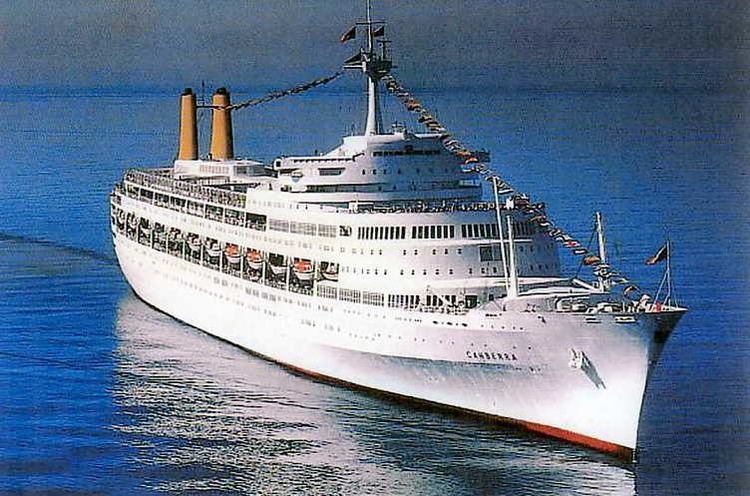 | ||
Owner 1961-1988, Peninsular & Oriental Steam Navigation Co. 1988-1991, P & O Lines (Shipowners) Ltd. 1991-1997, Abbey National March Leasing (1) Ltd. (Leased back by P & O) Operator 1961-66, P & O-Orient Lines, 1966-71, P & O Lines, 1971-1986, P & O Passenger Division. 1986-1992, Canberra Cruises Ltd. 1992-1994, P & O Cruise Fleets Services Ltd. 1994-1997, P & O Cruises (UK) Ltd. Route | ||
Ss canberra first lady of the p o
SS Canberra was an ocean liner, which later operated on cruises, in the P&O fleet from 1961 to 1997. She was built at the Harland and Wolff shipyard in Belfast, Northern Ireland at a cost of £17,000,000. The ship was named on 17 March 1958, after the federal capital of Australia, Canberra. She was launched on 16 March 1960, sponsored by Dame Pattie Menzies, GBE, wife of the then Prime Minister of Australia, Robert Menzies. She entered service in May 1961, and made her maiden voyage starting in June. In the 1982 Falklands War she served as a troop ship.
Contents
- Ss canberra first lady of the p o
- Ss canberra the return july 11 1982
- Early career
- Falklands War
- Final years
- Statistics
- References
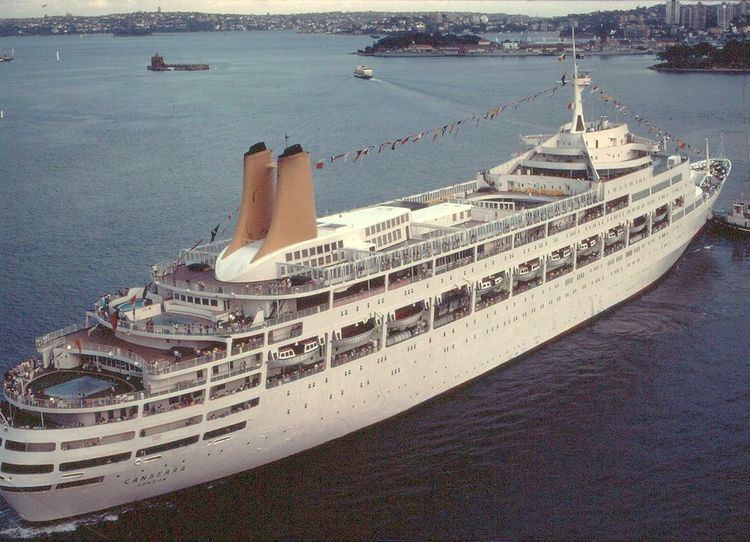
Ss canberra the return july 11 1982
Early career

P&O commissioned Canberra to operate the combined P&O-Orient Line service between the United Kingdom and Australia. The arrival of the jet airliner had already caused a drop in demand for this service; a reduction in emigration to Australia and wars forcing the closure of the Suez Canal saw the route become unprofitable. However a refit in 1974 saw Canberra adapted to cruising. Unusually, this transition from an early life as a purpose built ocean liner to a long and successful career in cruising, occurred without any major external alterations, and with only minimal internal and mechanical changes over the years. One of her public rooms included a 'Cricketers Tavern', which contained a collection of bats and ties from cricket clubs all over the world; she also had the William Fawcett reading/writing room, named after the engine designer of early P&O ships.
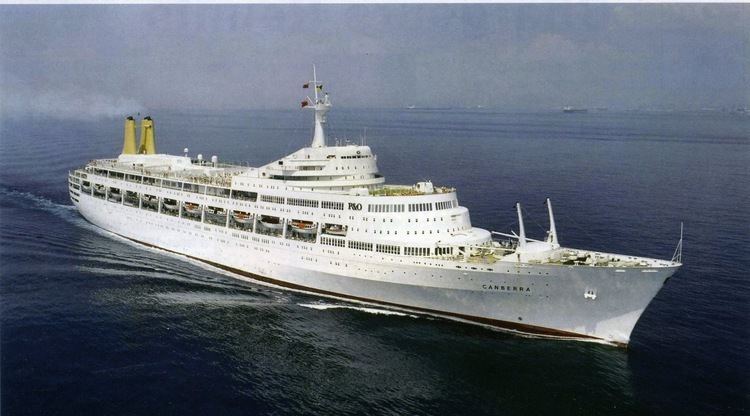
Like RMS Strathnaver and RMS Strathaird that she replaced on the Tilbury – Brisbane route, Canberra had turbo-electric transmission. Instead of being mechanically coupled to her propeller shafts, Canberra's steam turbines drove large electric alternators that provided current for electric motors that, in turn, drove the vessel's twin propellers. They were the most powerful steam turbo-electric units ever installed in a passenger ship; at 42,500 hp (31,700 kW) per shaft, they surpassed SS Normandie's 40,000 hp (30,000 kW) on each of her four shafts. This would give her a speed of about 27.25 knots (50.47 km/h). She also had a bow propeller for maneuvering in port and docking maneuvers. She was also the first British passenger liner to use alternating current as power.

There are several operational and economical advantages to such electrical de-coupling of a ship's propulsion system, and it became a standard element of cruise ship design in the 1990s, over 30 years after Canberra entered service. However, diesel engine and gas turbine driven alternators are the primary power source for most modern electrically propelled ships. She also had a bulbous bow, two sets of stabilizers, and two funnels side-by-side. The lifeboats, which were made from glass fibre, were placed three decks lower than usual for ships of her type, and were recessed into the hull to allow improved view from the passenger decks.
Falklands War
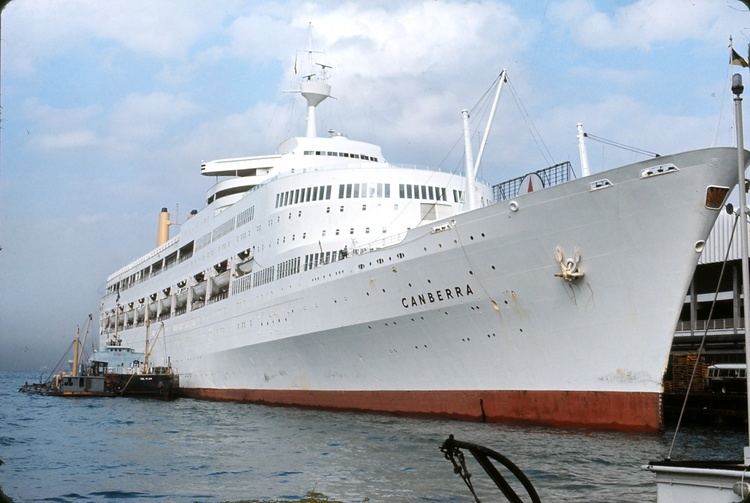
On 2 April 1982, Argentina invaded the Falkland Islands, which initiated the Falklands War. At the time, Canberra was cruising in the Mediterranean. The next day, her captain Dennis Scott-Masson received a message asking his time of arrival at Gibraltar, which was not on his itinerary. When he called at Gibraltar, he learnt that the Ministry of Defence had requisitioned Canberra for use as a troopship. Canberra sailed to Southampton, Hampshire where she was quickly refitted, sailing on 9 April for the South Atlantic.
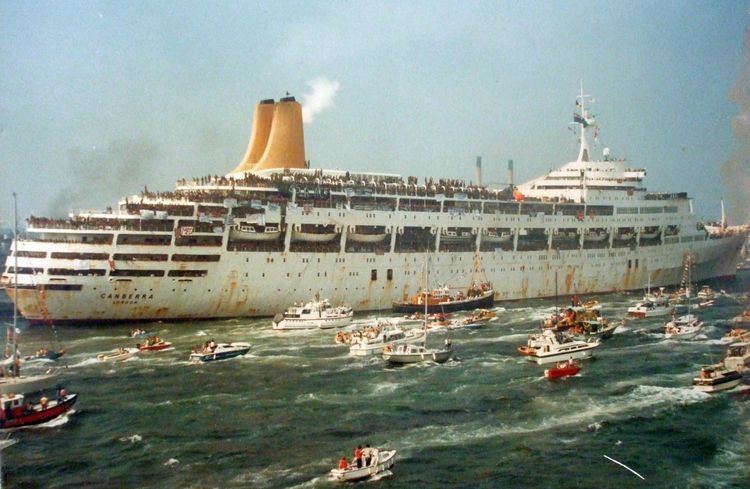
Nicknamed the Great White Whale, Canberra proved vital in transporting the Parachute Regiment and Royal Marines to the islands more than 9,000 nautical miles (17,000 km) from the United Kingdom. Canberra was sent to the heart of the conflict.
Canberra anchored in San Carlos Water on 21 May as part of the landings by British forces to retake the islands. Although her size and white colour made her an unmissable target for the Argentine Air Force, Canberra, if sunk, would not have been completely submerged in the shallow waters at San Carlos. However, the liner was not badly hit in the landings as the Argentine pilots tended to attack the Royal Navy frigates and destroyers instead of the supply and troop ships. After the war, Argentine pilots claimed they were told not to hit Canberra, as they mistook her for a hospital ship.
Canberra then sailed to South Georgia, where 3,000 troops were transferred from Queen Elizabeth 2. They were landed at San Carlos on 2 June. When the war ended, Canberra was used to repatriate captured Argentine soldiers, landing them at Puerto Madryn, before returning to Southampton to a rapturous welcome on 11 July. Captain Scott-Masson, who had started his apprenticeship on the Shaw, Savill & Albion Line troopship Empire Deben in the late 1940s, was awarded a CBE and made an Aide-de-Camp to Her Majesty The Queen.
Final years
After a lengthy refit, Canberra returned to civilian service as a cruise ship. Her role in the Falklands War made her very popular with the British public, and ticket sales after her return were elevated for many years as a result. Age and high running costs eventually caught up with her though, as she had much higher fuel consumption than most modern cruise ships. Although Premier Cruise Line had made a bid for the old ship, P&O had already decided that they did not want the Canberra to operate under a different flag. A replacement for the Canberra, the 1988-built Star Princess was transferred to P&O Cruises and was renamed Arcadia.
Canberra was withdrawn from P&O service in September 1997 and sold to ship breakers for scrapping on 10 October 1997, leaving for Gadani ship-breaking yard, Pakistan on 31 October 1997. Her deep draft meant that she could not be beached as far as most ships, and due to her solid construction the scrapping process took nearly a year instead of the estimated three months, being totally scrapped by the end of 1998.
The singer & song writer Gerard Kenny released the official tribute song to the ship "Farewell Canberra" at P&O's request as a single in 1997.
